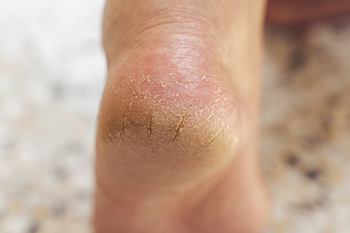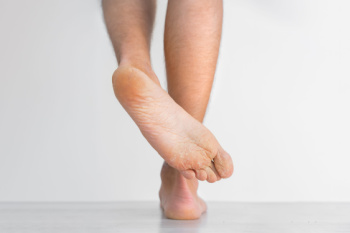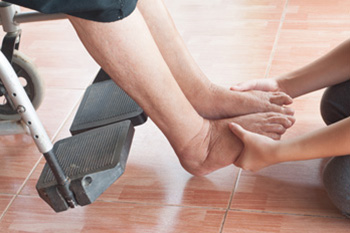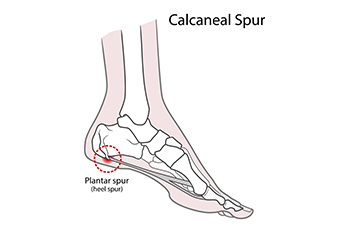Items filtered by date: February 2025
Heel Pain in the Morning?
Cracked Heels and Their Connection to Various Conditions

Cracked heels can result from several underlying causes, some of which are related to medical conditions. Athlete's foot, a fungal infection, can cause dryness and cracking of the skin on the heels. Hypothyroidism, which affects the thyroid gland, can lead to dry skin and a tendency for the skin to crack, especially on the heels. Diabetes can also contribute to cracked heels due to poor circulation and nerve damage, which can result in reduced moisture and skin resilience. Sjogren's syndrome, an autoimmune disorder that affects moisture-producing glands, can lead to dry skin, making heels more prone to cracking. Additionally, heel spurs, which are bony growths on the underside of the heel, can cause pressure and irritation, contributing to skin damage. If you have developed cracked heels, it is suggested that you consult a podiatrist who can offer effective treatment remedies, which may include prescribed medication.
If the skin on your feet starts to crack, you may want to see a podiatrist to find treatment. If you have any concerns, contact Brandon M. Zuklie, DPM from New Jersey. Our doctor can provide the care you need to keep you pain-free and on your feet.
Cracked Heels
It is important to moisturize your cracked heels in order to prevent pain, bleeding, and infection. The reason cracked heels form is because the skin on the foot is too dry to support the immense pressure placed on them. When the foot expands, the dry skin on the foot begins to split.
Ways to Help Heal Them
- Invest in a good foot cream
- Try Using Petroleum Jelly
- Ease up on Soaps
- Drink Plenty of Water
Ways to Prevent Cracked Heels
- Moisturize After Showering
- Skip a Shower
- Keep Shower Water Lukewarm
- Don’t Scrub Your Feet
If you are unsure how to proceed in treating cracked heels, seek guidance from a podiatrist. Your doctor will help you with any questions or information you may need.
If you have any questions, please feel free to contact our offices located in Piscataway, Jamesburg, and Branchburg, NJ . We offer the newest diagnostic and treatment technologies for all your foot care needs.
Tinea Pedis Is the Silent Invader

Tinea pedis, commonly known as athlete’s foot, is more than just an itchy nuisance. It is a fungal infection that thrives in warm, damp environments like locker rooms, public showers, and sweaty shoes. Many people do not realize they have it until symptoms like peeling skin, redness, and a burning sensation appear. The infection often starts between the toes but can spread to the soles and even the toenails, if left untreated. Ignoring tinea pedis can lead to chronic infections, cracked skin, and secondary bacterial infections. Prevention is key. Keeping feet dry, wearing breathable shoes, and avoiding walking barefoot in public spaces can reduce the risk. Mild antifungal treatments can help, but persistent or severe cases require medical attention. If symptoms worsen or do not improve, it is suggested that you see a podiatrist for stronger treatments and long-term solutions to keep your feet healthy.
Athlete’s Foot
Athlete’s foot is often an uncomfortable condition to experience. Thankfully, podiatrists specialize in treating athlete’s foot and offer the best treatment options. If you have any questions about athlete’s foot, consult with Brandon M. Zuklie, DPM from New Jersey. Our doctor will assess your condition and provide you with quality treatment.
What Is Athlete’s Foot?
Tinea pedis, more commonly known as athlete’s foot, is a non-serious and common fungal infection of the foot. Athlete’s foot is contagious and can be contracted by touching someone who has it or infected surfaces. The most common places contaminated by it are public showers, locker rooms, and swimming pools. Once contracted, it grows on feet that are left inside moist, dark, and warm shoes and socks.
Prevention
The most effective ways to prevent athlete’s foot include:
- Thoroughly washing and drying feet
- Avoid going barefoot in locker rooms and public showers
- Using shower shoes in public showers
- Wearing socks that allow the feet to breathe
- Changing socks and shoes frequently if you sweat a lot
Symptoms
Athlete’s foot initially occurs as a rash between the toes. However, if left undiagnosed, it can spread to the sides and bottom of the feet, toenails, and if touched by hand, the hands themselves. Symptoms include:
- Redness
- Burning
- Itching
- Scaly and peeling skin
Diagnosis and Treatment
Diagnosis is quick and easy. Skin samples will be taken and either viewed under a microscope or sent to a lab for testing. Sometimes, a podiatrist can diagnose it based on simply looking at it. Once confirmed, treatment options include oral and topical antifungal medications.
If you have any questions, please feel free to contact our offices located in Piscataway, Jamesburg, and Branchburg, NJ . We offer the newest diagnostic and treatment technologies for all your foot care needs.
Foot Care Tips for Seniors

As people age, foot care becomes increasingly important to maintain mobility and prevent discomfort. Seniors should check their feet daily for any signs of cuts, blisters, redness, or swelling. Keeping toenails trimmed and straight can prevent ingrown nails, which can be painful and lead to infection. Wearing comfortable, supportive shoes is crucial to avoid foot strain and prevent issues like bunions or arthritis pain. Common foot problems in seniors include neuropathy, which causes numbness or tingling, and poor circulation, leading to cold or discolored feet. Symptoms like persistent pain, swelling, or difficulty walking should not be ignored. A podiatrist can help diagnose and treat these issues, offering tailored solutions like custom orthotics, proper footwear recommendations, and medical treatments for conditions like fungal infections or corns. If you are experiencing foot pain or discomfort, it is time to consult a podiatrist. It is suggested that you schedule an appointment for expert care and advice.
Proper foot care is something many older adults forget to consider. If you have any concerns about your feet and ankles, contact Brandon M. Zuklie, DPM from New Jersey. Our doctor can provide the care you need to keep you pain-free and on your feet.
The Elderly and Their Feet
As we age we start to notice many changes in our body, but the elder population may not notice them right away. Medical conditions may prevent the elderly to take notice of their foot health right away. Poor vision is a lead contributor to not taking action for the elderly.
Common Conditions
- Neuropathy – can reduce feeling in the feet and can hide many life-threatening medical conditions.
- Reduced flexibility – prevents the ability of proper toenail trimming, and foot cleaning. If left untreated, it may lead to further medical issues.
- Foot sores – amongst the older population can be serious before they are discovered. Some of the problematic conditions they may face are:
- Gouging toenails affecting nearby toe
- Shoes that don’t fit properly
- Pressure sores
- Loss of circulation in legs & feet
- Edema & swelling of feet and ankles
Susceptible Infections
Diabetes and poor circulation can cause general loss of sensitivity over the years, turning a simple cut into a serious issue.
If you have any questions please feel free to contact our offices located in Piscataway, Jamesburg, and Branchburg, NJ . We offer the newest diagnostic and treatment technologies for all your foot and ankle needs.
Risk Factors for Heel Spurs

A heel spur is a bony growth that often forms on the underside of the heel bone, typically as a result of prolonged stress and pressure. This condition develops when calcium deposits accumulate over time, leading to the formation of a sharp point on the heel. Heel spurs are commonly caused by repetitive stress from activities like running or standing for long periods. Heel spurs can also be linked to other factors, including obesity, poor footwear, and certain medical conditions, such as arthritis. The symptoms of heel spurs include sharp pain in the heel, especially when walking or standing after long periods of rest. Swelling and inflammation surrounding the affected area are also common. Individuals with flat feet or high arches are at an increased risk, as these foot structures can put additional strain on the heel. If you have heel pain, it is strongly suggested that you promptly consult a podiatrist who can provide a proper diagnosis and treatment options.
Heel spurs can be incredibly painful and sometimes may make you unable to participate in physical activities. To get medical care for your heel spurs, contact Brandon M. Zuklie, DPM from New Jersey. Our doctor will do everything possible to treat your condition.
Heels Spurs
Heel spurs are formed by calcium deposits on the back of the foot where the heel is. This can also be caused by small fragments of bone breaking off one section of the foot, attaching onto the back of the foot. Heel spurs can also be bone growth on the back of the foot and may grow in the direction of the arch of the foot.
Older individuals usually suffer from heel spurs and pain sometimes intensifies with age. One of the main condition's spurs are related to is plantar fasciitis.
Pain
The pain associated with spurs is often because of weight placed on the feet. When someone is walking, their entire weight is concentrated on the feet. Bone spurs then have the tendency to affect other bones and tissues around the foot. As the pain continues, the feet will become tender and sensitive over time.
Treatments
There are many ways to treat heel spurs. If one is suffering from heel spurs in conjunction with pain, there are several methods for healing. Medication, surgery, and herbal care are some options.
If you have any questions feel free to contact our offices located in Piscataway, Jamesburg, and Branchburg, NJ . We offer the latest in diagnostic and treatment technology to meet your needs.

